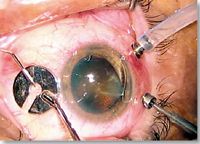Article
Minimally invasive transconjunctival surgery has advantages
Montreal—Twenty-three gauge sutureless transconjunctival pars plana vitrectomy is effective for certain diseases of the posterior segment. The technique has the advantages of minimally invasive transconjunctival surgery without some of the limitations associated with 25-gauge surgery, reported Reza Iranmanesh, MD.

He demonstrated the differences in forceps and in the calipers of various cutters between the two systems and compared the functional flexibility of 20-, 23-, and 25-gauge instruments at the American Society of Retina Specialists annual meeting in Montreal. He pointed out that the flexibility of the 23- and 25-gauge instruments was comparable, but the former had less flexibility.
Dr. Iranmanesh and his colleagues Richard Spaide, MD, and Yale Fisher, MD, conducted a retrospective study of 33 eyes of 33 consecutive patients. Patients were considered for surgery if they had a macular hole (12 eyes), a vitreous hemorrhage (eight eyes), a tractional retinal detachment (four eyes), an epiretinal membrane (two eyes), rhegmatogenous retinal detachment (two eyes), a retained lens fragment (two eyes), vitreomacular traction syndrome (two eyes), or vitritis (one eye).

"The infusion tubing connects to the outside of the first cannula, which we believe allows for better flow than a system that connects within the cannula itself," Dr. Iranmanesh said.
Once inside the eye, he explained, the surgery greatly resembles that of a 20-gauge vitrectomy. All the maneuvers can be performed easily with the 23-gauge instruments, he said. He also demonstrated a peeling of a macular pucker using forceps in a case of vitreomacular traction syndrome.
At the end of surgery, the cannulas are easily and slowly pulled out. The wounds are self-sealing. Dr. Iranmanesh pointed out his preference for briefly using a cotton tip at the sclerotomy site upon removing the cannulas. It is common to have a small amount of subconjunctival hemorrhage at the entry site, he noted.
"Our results were favorable. We were able to accomplish the immediate surgical goal in all cases. One sclerotomy site required suturing and there was one case of postoperative hypotony that resolved without intervention or complication. The mean postoperative pressure in all cases was 21 mm Hg on the first day after surgery," Dr. Iranmanesh reported.
Less patient discomfort
He also pointed out that the level of patient discomfort seemed to be less than that with a 20-gauge vitrectomy and comparable to that with 25-gauge vitrectomy.
"The 23-gauge trocars are definitely more difficult to place given the two-step nature of the insertion. In addition, they also cause a small conjunctival hemorrhage. The wound closure may be superior with a 23-gauge sclerotomy compared with a 25-gauge sclerotomy because of the angle of entry into the sclera," he said. Dr. Iranmanesh demonstrated that in patients who underwent 23-gauge surgery there was a small wound visible, but in patients who underwent 20-gauge surgery inflammation can be present for months around the entry site after the surgery.
Newsletter
Don’t miss out—get Ophthalmology Times updates on the latest clinical advancements and expert interviews, straight to your inbox.




